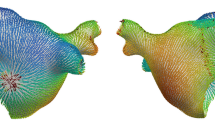Abstract
A novel parametric model-based method was developed to quantify epicardial conduction patterns and velocity in an isolated Langendorff-perfused rabbit heart. The method incorporated geometric and anatomical features of the left and right ventricles into the analysis. Optical images of propagation were obtained using the voltage-sensitive dye DI-4-ANEPPS, and a high-speed digital camera. Activation maps were extracted from these images and interpolated onto a three-dimensional finite-element model of epicardial geometry and fiber structure. Activation time was expressed as a function of local parametric coordinates, and a conduction velocity vector field was computed from the gradient of the scalar field. Activation times measured using bipolar electrodes did not differ significantly from times measured using the optical mapping technique. The method was able to detect a 34% decrease in average fiber velocity and a 28% decrease in average cross-fiber velocity following the addition of 0.5 mM heptanol into the perfusate. The combination of optical mapping with a three-dimensional geometric model of the ventricles provides a new tool to quantify wave-front propagation relative to anatomy at a relatively high spatial resolution. © 2000 Biomedical Engineering Society.
PAC00: 8719Nn, 8719Hh, 8719Ff, 8762+n, 8710+e
Similar content being viewed by others
REFERENCES
Baxter, W. T., J. M. Davidenko, L. M. Loew, J. P. Wuskell, and J. Jalife.Technical features of a CCD video camera system to record cardiac fluorescence data. Ann. Biomed. Eng.25:713–725, 1997.
Bayly, P. V., B. H. KenKnight, J. M. Rogers, R. E. Hillsley, R. E. Ideker, and W. M. Smith. Estimation of conduction velocity vector fields from epicardial mapping data. IEEE Trans. Biomed. Eng.45:563–571, 1998.
Cheng, Y., K. Mowrey, I. R. Efimov, D. R. Van Wagoner, P. J. Tchou, and T. N. Mazgalev. Effects of 2,3-butanedione monoxime on atrial-atrioventricular nodal conduction in isolated rabbit heart. J. Cardiovasc. Electrophysiol. 8:790–802, 1997.
Costa, K. D., P. J. Hunter, J. S. Wayne, L. K. Waldman, J. M. Guccione, and A. D. McCulloch. A three-dimensional finite-element method for large elastic deformations of ventricular myocardium: II—Prolate spheroidal coordinates. J. Biomech. Eng.118:464–472, 1996.
de Bakker, J.M. T., R. N. W. Hauer, and T. A. Simmers. Activation mapping: Unipolar versus bipolar recording. In: Cardiac Electrophysiology: From Cell to Bedside, edited by D. P. Zipes and J. Jalife. Philadelphia: Saunders, 1995, pp. 1068–1078.
Dillon, S. M., M. A. Allessie, P. C. Ursell, and A. L. Wit. Influences of anisotropic tissue structure on reentrant circuits in the epicardial border zone of subacute canine infarcts. Circ. Res.63:182–206, 1988.
Efimov, I. R., D. T. Huang, J. M. Rendt, and G. Salama. Optical mapping of repolarization and refractoriness from intact hearts. Circulation90:1469–1480, 1994.
Girouard, S. D., K. R. Laurita, and D. S. Rosenbaum. Unique properties of cardiac action potentials recorded with voltagesensitive dyes. J. Cardiovasc. Electrophysiol.7:1024–1038, 1996.
Gray, R. A., J. Jalife, A. Panfilov, W. T. Baxter, C.Cabo, J. M. Davidenko, and A. M. Pertsov. Nonstationary vortexlike reentrant activity as a mechanism of polymorphic ventricular tachycardia in the isolated rabbit heart. Circulation91:2454–2469, 1995.
Gray, R. A., A. M. Pertsov, and J. Jalife. Spatial and temporal organization during cardiacfibrillation. Nature (London) 392:75–78, 1998.
Knisley, S. B. Transmembranevoltage changes during unipolar stimulation of rabbit ventricle. Circ. Res.77:1229–1239, 1995.
91 Model-Based Activation Mapping
Knisley, S. B., and T. C. Baynham. Line stimulationparallel to myofibers enhances regional uniformity of transmembrane voltage changes in rabbit hearts. Circ. Res.81:229–241, 1997.
Liu, Y., C. Cabo, R. Salomonsz, M. Delmar, J. Davidenko, and J. Jalife. Effects of diacetyl monoxime on the electrical properties of sheep and guinea pig ventricular muscle. Cardiovasc. Res.27:1991–1997, 1993.
Mazhari, R., J. H. Omens, L. K. Waldman,and A. D. Mc-Culloch. Regional myocardial perfusion and mechanics: a model-based method of analysis. Ann. Biomed. Eng.26:743–755, 1998.
Meier, G. D., M. C. Ziskin, W. P. Santamore, and A. A. Bove. Kinematics of the beating heart. IEEE Trans. Biomed. Eng.27:319–329, 1980.
Ndrepepa, G., E. B. Caref, H. Yin, N. el-Sherif, and M. Restivo. Activationtime determination by high-resolution unipolar and bipolar extracellular electrograms in the canine heart. J. Cardiovasc. Electrophysiol.6:174–188, 1995.
Nielsen, P. M., I. J. Le Grice, B. H. Smaill, and P. J. Hunter. Mathematical model of geometry and fibrous structure of the heart. Am. J. Physiol.260:1365–1378, 1991.
Reiter, M. J., M. Landers, Z. Zetelaki, C. J. H. Kirchhof, and M. A. Allessie. Electrophysiological effects of acute dilation in the isolated rabbit heart. Cycle length-dependent effects on ventricular refractoriness and conduction velocity. Circulation96:4050–4056, 1997.
Rousakov, S. V., J. P. Wikswo, and R. R. Aliev. Wavevector analysis ofcardiac activation patterns. Proceedings of the First Joint BMES/EMBS Conference, Atlanta, GA 13–16 October1999, p. 161.
Salama, G., A. Kanai, and I. R. Efimov. Subthresholdstimulation of Purkinje fibers interrupts ventricular tachycardia in intact hearts. Experimental study with voltage-sensitive dyes and imaging techniques. Circ. Res.74:604–619, 1994.
Smeets, J. L.,M. A. Allessie, W. J. Lammers, F. I. Bonke, and J. Hollen. The wavelength of the cardiac impulse and reentrant arrhythmias in isolated rabbit atrium. The role of heart rate, autonomic transmitters, temperature, and potassium. Circ. Res.58:96–108, 1986.
Streeter, Jr., D. D., and W. T. Hanna.Engineering mechanics for successive states in canine left ventricular myocardium. I. Cavity and wall geometry. Circ. Res.33:639–655, 1973.
Vetter, F. J., and A. D. McCulloch. Three-dimensional analysis of regional cardiac function: A model of rabbit ventricular anatomy. Prog. Biophys. Mol. Biol.69:157–183, 1998.
Author information
Authors and Affiliations
Rights and permissions
About this article
Cite this article
Sung, D., Omens, J.H. & McCulloch, A.D. Model-Based Analysis of Optically Mapped Epicardial Activation Patterns and Conduction Velocity. Annals of Biomedical Engineering 28, 1085–1092 (2000). https://doi.org/10.1114/1.1314891
Issue Date:
DOI: https://doi.org/10.1114/1.1314891




